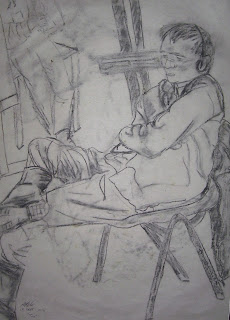 |
| Charlotte, 18 Sept 1991 |
This economical grey sugar paper was routinely used during drawing classes. If I recall rightly, we students were charged only 2p per A2-size sheet, which was a large part of its attraction. (This was some 30 years ago, remember!)
 |
| James Loftus, 25 Jan 1990 |
Jim went on to study sculpture at Sheffield (?), and still produces art today.
 |
| One of The Twins, 22 Sept 1990 |
 |
| Tony O'Connell (AKA Toc), 18 Sept 1991 |
I still have several pieces from this session, usually stored in an A1-size PVC portfolio case bought for art school but rarely used for anything other than storage due to its weight and cumbersome size which made it a royal pain to struggle onto buses then haul up the long stone staircase to the top floor art studios on college. When we students were required to present our portfolios for assessments, then this case had to be used. Still, it's still in use now for storing my old student work.
These two charcoal drawings were both done on 18th September 1991, but I can't recall the names of either of these students.
 |
| Angie, c. 1991 |
Angie, (surname unknown), was one of the two life models regularly employed by the college. This was an informal study of her, possibly on a day when the heating was so poor that the usual life drawing session had to be re-thought.
 |
| Billy, with Dave McKay at an easel, 26 Nov 1991 |
I include this last one even though it's not a particularly good life drawing, but because it completes my theme of sharing drawings of fellow students. In the corner, at an easel, you can see Dave McKay busily working away. While he was a student, he had a part time job as a security guard in St George's Hall, and routinely played his choice of music in the shared art studio rooms - Midnight Oil and Ministry were seemingly his favourites.



Comments